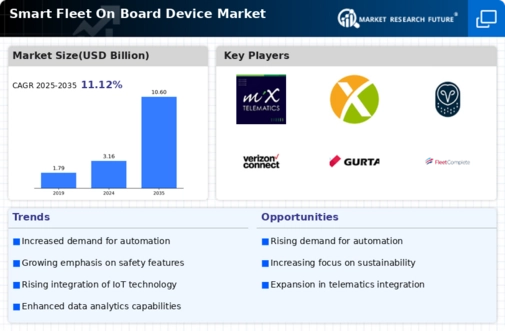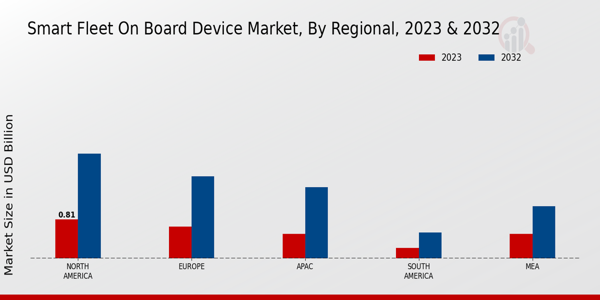Rising Fuel Costs
Rising fuel costs are a significant concern for fleet operators, driving the demand for smart fleet solutions within the Global Smart Fleet On Board Device Market Industry. As fuel prices continue to fluctuate, companies are seeking ways to optimize fuel efficiency and reduce operational costs. Smart fleet technologies, such as route optimization and fuel management systems, enable operators to monitor fuel consumption and identify inefficiencies. By implementing these solutions, companies can achieve substantial savings, thus making the investment in smart fleet devices more appealing. This trend is expected to contribute to the market's growth, as operators prioritize cost-effective measures.
Regulatory Compliance
Regulatory compliance is a crucial driver for the Global Smart Fleet On Board Device Market Industry, as governments worldwide implement stricter regulations regarding emissions and safety standards. Fleet operators are increasingly required to adopt technologies that ensure compliance with these regulations, such as electronic logging devices and advanced telematics systems. This shift not only helps in meeting legal requirements but also promotes sustainability by reducing carbon footprints. The increasing emphasis on environmental regulations is likely to propel the market forward, as companies invest in smart fleet solutions to avoid penalties and enhance their reputations.
Growing E-commerce Sector
The growing e-commerce sector is significantly impacting the Global Smart Fleet On Board Device Market Industry, as logistics and delivery companies seek efficient fleet management solutions. The surge in online shopping has led to increased demand for timely deliveries, prompting companies to adopt smart fleet technologies that enhance operational efficiency. Solutions such as GPS tracking, automated dispatching, and real-time inventory management are becoming essential for meeting customer expectations. This trend is expected to drive market growth, as businesses invest in smart fleet devices to streamline their operations and improve service delivery.
Increased Focus on Safety
The increased focus on safety within the Global Smart Fleet On Board Device Market Industry is driving the adoption of advanced safety technologies. Fleet operators are recognizing the importance of ensuring the safety of their drivers and vehicles, leading to the integration of features such as collision avoidance systems, driver behavior monitoring, and real-time alerts. These technologies not only enhance safety but also reduce accident-related costs and liabilities. As safety becomes a priority, the demand for smart fleet solutions is likely to rise, further propelling market growth. This trend aligns with the broader industry movement towards safer transportation practices.
Market Growth Projections
The Global Smart Fleet On Board Device Market Industry is projected to experience substantial growth, with estimates indicating an increase from 3.16 USD Billion in 2024 to 10.6 USD Billion by 2035. This growth trajectory suggests a compound annual growth rate (CAGR) of 11.65% from 2025 to 2035. Such projections highlight the increasing adoption of smart fleet technologies across various sectors, driven by factors such as technological advancements, regulatory compliance, and the need for operational efficiency. As the market evolves, stakeholders are likely to explore innovative solutions to meet the demands of a rapidly changing transportation landscape.
Technological Advancements
The Global Smart Fleet On Board Device Market Industry is experiencing rapid technological advancements that enhance vehicle tracking and management. Innovations such as real-time data analytics, artificial intelligence, and machine learning are being integrated into fleet management systems. These technologies enable companies to optimize routes, reduce fuel consumption, and improve overall operational efficiency. For instance, the adoption of AI-driven predictive maintenance can significantly lower downtime and repair costs. As a result, the market is projected to grow from 3.16 USD Billion in 2024 to 10.6 USD Billion by 2035, reflecting a strong demand for advanced fleet solutions.
















